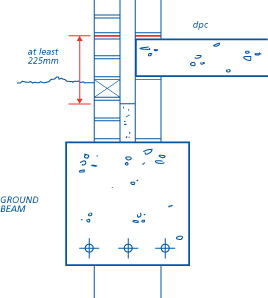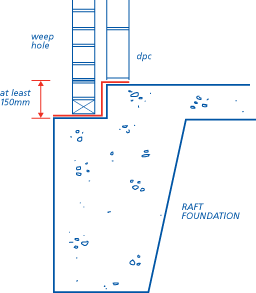4.5 Raft, pile, pier and beam foundations
SCOPE
DESIGN STANDARDS
Design that follows the guidance below will be acceptable for raft, pile, pier and beam foundations.
STATUTORY REQUIREMENTS AND OTHER STANDARDS
Design should be in accordance with relevant Building Regulations and other statutory requirements.
Relevant British Standards and Codes of Practice include:
| BS 648 | Schedule of weights of building materials |
| BS EN 1991 | Actions on structures |
| BS EN 1992 | Design of concrete structures |
| BS EN 1997-1 | Geotechnical design:General rules |
| BS 10175 | Investigation of potentially contaminated sites - Code of practice. |
HAZARDOUS GROUND
Where there is hazardous ground, the foundation design must be carried out by an Engineer in accordance with Technical Requirement R5.
Details of ground hazards to be taken into consideration are given in Chapters:
4.1 'Land quality - managing ground conditions'
NOTIFICATION
NHBC Rules state:
"If a Home is to be constructed on a Hazardous Site you must before making an Application for Inspection notify the NHBC in writing of the particular hazards which arise. You must do this at least 8 weeks before work begins on the site."
SUPERVISION BY AN ENGINEER
The visits by the Engineer are necessary so that the Engineer can be satisfied that the design of the foundation is suitable for the actual ground conditions encountered and that the construction is in accordance with the design.
REQUIREMENT FOR FOUNDATIONS
Elements requiring foundations include the following:
- external walls
- separating (party) walls
- chimney breasts
- piers
- internal loadbearing or masonry walls
- sleeper walls.
SITE CONDITIONS
Items to be taken into account include:
(a) site and ground appraisals
All information relating to the site and its ground conditions which is necessary for full and proper foundation design should be obtained.
(b) dwelling design
Foundation design should take account of the shape, size and construction of the dwellings as well as the site layout.
Foundations for terraced dwellings may require special precautions to prevent damage from differential settlement.
(c) site layout
Building over changes in ground characteristics should be avoided.
(d) site levels
Stepped foundations and suspended floor slabs may be needed for sloping sites.
(e) sulfate and acids in ground or groundwater
Sulfates and other chemicals can cause expansion and disruption of concrete. Also, high acidity, for example in peat, or permeable soil with acidic groundwater, can cause damage to concrete. Where concrete is at risk from chemical attack from the ground or where the groundwater is highly mobile, the level of sulfate and other chemicals should be determined, in terms of the ACEC Class (Aggressive Chemical Environment for Concrete Class) in accordance with BRE Special Digest 1. Where sulfates or high acidity in ground or groundwater are present, reference should be made to Chapter 2.1 'Concrete and its reinforcement' (each section) for guidance concerning acceptable concrete mixes.
(f) trees
Where trees are nearby or are to be planted nearby (especially where the soil is shrinkable), foundations should be designed as shown in Chapter 4.2 'Building near trees'.
(g) frost susceptible soils
To avoid damage from frost action, the depth to the underside of the foundation in frost susceptible ground should be at least 450mm below finished ground level.
DIFFERENTIAL SETTLEMENT
Foundations should be designed to avoid any local stress points or any differential settlement. Foundations for attached bays, porches, garages, conservatories and other structures should be a continuation of those for the main dwelling, unless the design indicates an alternative which takes account of differential movement, for example separate foundations. Foundations adjoining those of an existing building may require special precautions to limit differential movement.
SERVICES, INCLUDING DRAINAGE
Where services are to pass through, or under, foundations provision should be made for suitable ducts or lintels to enable them to be installed later, in such a way as not to impair structural stability. For further details, reference should be made to the Design and Sitework sections of Chapters:
5.1 'Substructure and ground bearing floors'
5.3 'Drainage below ground'
8.1 'Internal services'.
MOVEMENT JOINTS
Movement joints should be located so as to limit the risk of damage caused by movement. Suitable materials are given in the Materials section.
DAMP-PROOFING
Items to be taken into account include:
(a) a drained cavity
Cavity walls should drain below dpc and prevent water flooding cavities above dpc levels or crossing from the outside to the inside. A clear cavity of 225mm minimum below dpc is required. Where foundations other than strip or trench fill are used, including those for timber framed dwellings, this may be reduced to 150mm minimum below dpc provided that weep holes and other measures, where necessary, are taken to ensure that the cavity can drain freely. Dpc cavity trays are not an acceptable weather-proofing to the edges of specialised foundations, such as rafts and ground beams.

(b) damp-proof membranes
For the provision of damp-proof membranes, reference should be made to Chapters 5.1 'Substructure and ground bearing floors' (each section) and 5.2 'Suspended ground floors' (each section).
SAFE TRANSMISSION OF LOADS
Items to be taken into account include:
RAFT FOUNDATIONS
Rafts and semi-rafts should:
- meet Clauses D1 to D12, where applicable
- prevent the erosion of ground beneath the raft
- be designed to accommodate, where required, warm air ducts, service ducts or services without any adverse effect upon performance of the foundation.
Where appropriate, precautions should be taken to limit the risk of ducts becoming flooded.
Semi-raft foundations on made ground should follow the guidance given in Appendix 4.5-A.
For details of suitable fill for raft foundations, refer to Chapter 5.1 'Substructure and ground bearing floors' Appendix 5.1-A.
PILED FOUNDATIONS
Piled foundations should:
- meet Clauses D1 to D12, where applicable
- follow the guidance given in Sitework clause 4.5 - S11.
The design should specify precautions to be taken in cohesive soils where volume changes can occur.
The bearing capacity and integrity of piles should be confirmed by testing, when required.
PIER/PAD AND BEAM FOUNDATIONS
Pier/pad and beam foundations should:
- meet Clauses D1 to D12, where applicable.
VIBRATORY GROUND IMPROVEMENT TECHNIQUES
Vibratory ground improvement should:
- meet Clauses D1 to D12, where applicable
- comply with Chapter 4.6 'Vibratory ground improvement techniques'.
PROVISION OF INFORMATION
All relevant information needed for the completion of the sitework should be stated clearly and unambiguously and be readily available to all concerned.
All necessary dimensions and levels should be indicated and related to:
- at least one bench mark, and
- reference points on site.
Details should be provided with respect to:
- dimensions, type and depth of foundations
- junctions
- steps
- movement and construction joints
- detailing of ducts
- location of services
- critical sequences of construction.
Designers need to be aware of the ground conditions and, in particular, any features requiring special attention, such as any existing sewers or other services, levels of water table and the presence of any deleterious substances, especially sulfates.
Where toxic materials (or materials likely to present a health hazard) are found, all available information should be supplied to NHBC, together with proposals for dealing with the hazard.





















